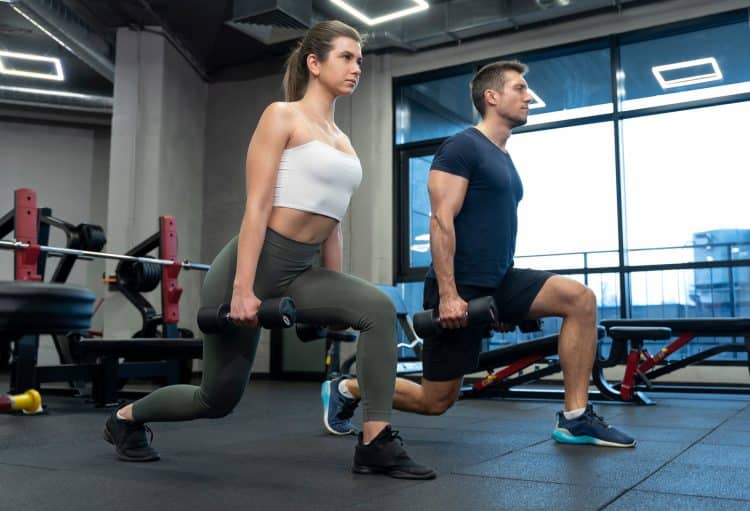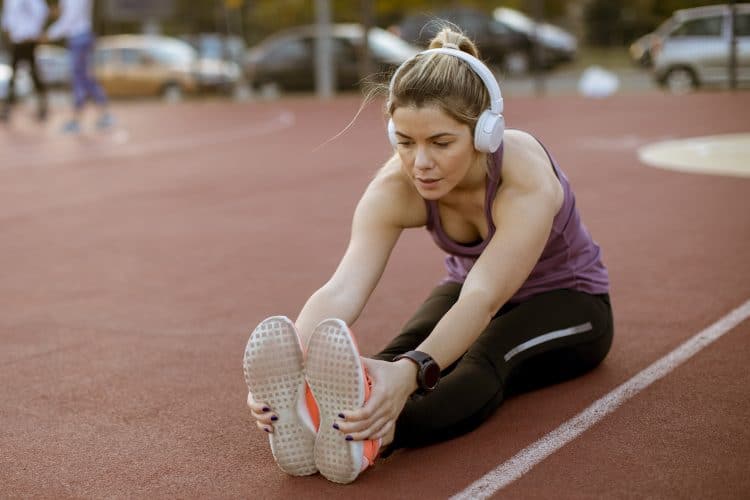Sitting is part and parcel of modern life. Many people earn a living while seated, travel while seated, and then spend their leisure time seated. And, if you go to a gym, your workout will probably include seated exercises, too.
As a result, the average American spends as much as 60% of their day sitting or otherwise sedentary – about 15 hours. In contrast, people living in less developed, more rural places spend as little as three hours a day sitting (1, 2). Unfortunately, while sitting is often commonplace and hard to avoid, it may also be bad for your health. Even regular exercisers are not immune to the damaging effects of sitting too much. It’s also possible to be an ardent exerciser and too sedentary to be healthy.
In this article, we reveal the dangers of too much sitting and what you can do to minimize its harmful effects.
The Effects of Sitting Too Much
While it may be hard to believe that sitting is bad for your health, numerous studies have linked sitting and other sedentary behaviors to various adverse effects and health risks. These include:
Weight Gain

With a large and growing percentage of adults and kids overweight or obese, it’s clear that weight gain is a big problem in almost every developed country. While dietary changes are partly to blame, i.e., the easy availability of highly calorific junk food, lack of physical activity is also a factor.
Sitting is a very passive activity. Your chair supports your weight, so you don’t have to use your muscles to maintain your position. This passivity reduces your caloric expenditure significantly.
To put this in perspective, office workers burn an average of 1,000 fewer calories than manual laborers and agricultural workers. Such a low daily caloric expenditure increases the likelihood of weight gain and makes it much harder to lose weight. Statistics show that obese people tend to sit an average of two more hours than those of a healthy weight (3).
Related: See how many calories you burn while sitting here.
Poor Posture
Posture is the alignment of your joints, and it can be good or bad. Good posture requires minimal muscle tension and tends to stress your joints in an even, balanced way. While it is possible to sit in good posture, prolonged sitting still causes some muscles to tighten while stretching and weakening others, pulling joints out of optimal alignment. This causes tension and pain, and joints are loaded unevenly, increasing structural wear and tear, and is a leading cause of low back pain.
It’s no coincidence that office workers often suffer from back and neck pain. Many even look like they’re sitting even when they’re standing, i.e., a rounded upper and lower back and forward head position.

Linked to Disease and an Early Death
The less active you are, the more likely you are to die early. Studies show that sedentary people have a 22–49% greater risk of early death (4). However, given that sitting is one of the most common sedentary behaviors, it’s clear there is a link between sitting more and dying sooner.
Diseases commonly associated with sedentarism that can also shorten your life include:
- Abnormal cholesterol levels
- Cancer
- Coronary heart disease
- Diabetes
- Heart attack
- Increased blood pressure
- Metabolic syndrome
- Obesity
- Osteoporosis
- Stroke
There are also strong links between sedentarism and mental/brain health, e.g., an increased risk of dementia, Alzheimer’s disease, anxiety, depression, etc.
Lost Mobility and Lower Quality of Life
The less physically active you are now, the less physically capable you’re likely to be when you’re older. This can significantly reduce mobility, strength, and quality of life in your later years.
Sitting involves very little muscular work, and, as such, your muscles will weaken through lack of use. Exercise can help, but a couple of workouts a week won’t offset spending the rest of your time sitting in a chair.
Age-related muscle loss, called sarcopenia, is unavoidable. However, it can be delayed and slowed to a crawl by leading an active lifestyle, i.e., sitting less and moving more.
Related: Sitting vs. Standing Calories Burned Calculator
Strategies for Sitting Less
Exercise is good for everybody’s body. However, some research suggests that even regular exercise may not offer much protection from the damaging effects of prolonged sitting (5). Rather, the best solution is to try and spend less time sitting.
While this might sound difficult, especially if you have an office or driving job, there are actually several effective strategies you can use to get yourself up and moving more.
These include:
1. Take Microbreaks From Sitting

Sitting for long periods is very easy, especially when you are engaged in whatever you are doing, e.g., working or watching TV. Before you know it, you’ve been sitting in the same position for several hours without moving.
One way to avoid this is to break up long periods of sitting with microbreaks. These breaks are small enough that they won’t disrupt your productivity or relaxation but long enough to get your body moving and offset some of the negative effects of sedentarism.
One way to do this is with the pomodoro method. Named after the famous tomato-shaped kitchen timer, this system for increasing productivity involves taking a five-minute break every 25 minutes, and a 15-minute break every two hours, so:
- Work/sit for 25 minutes
- Move for 5 minutes
- Work/sit for 25 minutes
- Move for 5 minutes
- Work/sit for 25 minutes
- Move 5 minutes
- Work/sit for 25 minutes
- Move for 15 minutes
- Work/sit for 25 minutes
- Move 5 minutes, etc.
You can do whatever you want during your five and 15-minute breaks, so long as it doesn’t involve more sitting. Good options include:
If such frequent microbreaks are inconvenient, try taking a five-minute break every hour.
However, don’t rely on your time-keeping skills to remind you to get up and move. Instead, use a timer on your watch or phone or download one of the many pomodoro apps now available. Some smartwatches also have movement alarms to remind you to stand up and shake off the effects of prolonged sitting.
2. Look for More Walking Opportunities

If sitting is one of the worst things you can do for your health, walking is arguably one of the best. In fact, walking is the perfect antidote to prolonged sitting.
It’s very easy to fall into the trap of barely walking at all. Mechanized transport, elevators and escalators, drive-throughs, food delivery services, etc., means that walking is almost optional. Needless to say, the less walking you do, the more time you’ll probably spend sitting.
So, look for opportunities to walk more. By default, this will invariably mean you spend a lot less time sitting. Good options include:
- Walk any journey of less than a mile/20 minutes
- Go for a walk during your lunch break
- Walk to another floor to use the bathroom/water dispenser
- Walk to see colleagues instead of calling or emailing them
- Take the stairs instead of riding in an elevator
- Park further away from work or the store and walk the rest of the way
- Walk to the coffee shop or takeout instead of ordering in
- Walk your kids to school instead of driving them
- Have walking meetings instead of meeting in the boardroom
- Try a treadmill desk
- Walk around the gym rather than resting passively between sets
- Do fewer seated exercises at the gym
Even the most office-bound person should be able to find numerous opportunities to walk more and sit less. Track your steps and try to clock up at least 10,000 each day.
3. Try a Standing Desk
Standing desks are pretty trendy, but that doesn’t mean they aren’t effective. Standing engages more muscles than sitting, and you are more likely to shift your weight and fidget, breaking you out of that fixed posture.
Of course, it’s as easy to stand in bad posture as it is to sit in it, so you’ll need to set your desk up properly to avoid hunching and slouching. However, used correctly, a standing desk can be a real lower back saver and will get you up off your butt so you spend less time sitting.
Adjustable desks that allow you to alternate between sitting and standing are ideal as they’re more versatile and will allow you to ease into going chairless.
4. Seek Out More Active Leisure Activities

Despite sitting so much at work, many people spend most of their leisure time seated, too. After a hard day at the office, who doesn’t want to just crash on the sofa binge-watching Netflix?
Unfortunately, while this is undoubtedly relaxing, more time spent sitting won’t do much to break you out of your sedentarism rut.
So, at least a few times a week, try to engage in more active leisure activities. This doesn’t have to be sport or exercise but should involve physical movement and time on your feet.
Good options include:
- Nature walks
- Casual games of basketball, baseball, soccer, touch football, Ultimate Frisbee, etc.
- Play with your kids
- Explore your neighborhood
- Go to the gym
- Do some gardening or chores
- Go for a walk with friends instead of hanging out at home
- Walk your dog
- Go for a walk after dinner
- Walk to a nearby restaurant to eat
- Walk rather than drive to your local coffee shop
- Walk to visit friends
That’s not to say you have to give up watching TV or you can’t enjoy going to the movies from time to time. However, these passive activities should be balanced with more energetic leisure activities.
5. Follow a Corrective Exercise Program
As discussed, sitting can do a lot of damage to your muscles and skeletal system. It causes some muscles to tighten up while others are stretched and weakened. While sitting less and moving more will help partially alleviate this problem, you’ll probably benefit from a more prescriptive corrective program.
Because of the effects of sitting, most people need to stretch their:
- Calves
- Hamstrings
- Adductors
- Hip flexors
- Rectus abdominis
- Neck flexors
- Pectoralis major
- Anterior deltoids

Conversely, the following muscles usually need strengthening:
- Gluteus maximus
- Abductors
- Core
- Middle trapezius
- Rhomboids
- Posterior deltoids
- Neck extensors
A few weeks of corrective training will do wonders for your posture and help alleviate much of the pain caused by prolonged sitting.
Related: Exercises to Fix Your Nerd Neck and Desk Slouch
6. Set up an Ergonomic Workstation
Sitting, especially at work, is largely unavoidable, so it’s worth trying to make it as safe and comfortable as possible. This means setting up your desk in the most ergonomic way you can.
There are lots of theories on what desk setup is best, but some general guidelines include the following:
- Adjust the height of your chair so your feet are flat on the floor
- Knees bent to around 90 degrees and level with your hips
- A supportive, comfortable chair
- Monitor about an arm’s length away and straight in front of you
- Elbows bent to about 90 degrees, shoulders relaxed
- Wrists flat on your desk
- Mouse within easy reach
- Good lighting
Your desk and chair can affect your productivity, and the more comfortable you are, the better you’ll be able to concentrate and the more work you’ll be able to do. So, if your chair or desk is causing you problems, let your boss know and explain how you’ll be able to do a better job if they spring for an ergonomic workstation.
Of course, if you work for yourself, you’ll need to buy these things, but they’re probably a tax-deductible expense.
7. Drink More Water

Drinking more water can act as an indirect reminder to get up and walk more. Increasing your water intake means you’ll need more bathroom breaks, forcing you to leave the confines of your chair and take a quick walk.
So, if you keep forgetting to move around, drink more water and let your bladder be your alarm clock. Plus, being more hydrated is good for many aspects of your health and can even help you lose weight by making you feel full, so you eat less.
Talk about a win-win situation!
Frequently Asked Questions
Do you have a question about the damaging effects of sitting? No problem, because we’ve got the answers!
1. In terms of calorie burning, how does sitting compare to walking?
Sitting is a very passive activity using much less muscle tension. As such, sitting burns fewer calories per hour than walking. That said, the number of calories used during these activities will depend on several factors, including your weight, muscle mass, age, and gender. So, any calculation of calories burned will be an approximation.
Using online calculators, we estimate that a 180-pound male will burn approximately 110 calories by sitting for an hour but 300 while walking at a moderate pace. Standing falls roughly halfway between these two extremes.
2. Could too much sitting be why I struggle to lose weight?
Spending prolonged periods sitting makes it very hard to create a big enough calorie deficit to lose weight. In contrast, more physical activity, e.g., walking, exercising, or doing chores, can significantly increase your daily calorie expenditure, which, depending on your diet, will probably make it easier to lose weight.
As little as five minutes of movement, most waking hours, can add a considerable amount to your daily energy expenditure, so look for ways to sit less and move more.
3. What does sedentary mean, and why is it so bad?
Sitting or lying down when you are awake are examples of sedentary behaviors.
Most people are sedentary when watching TV, using a computer or other screens, driving, or studying.
Sedentary behaviors are associated with weight gain and poor health, even if you are a regular exerciser. For example, being sedentary increases the risk of obesity, some cancers, coronary heart disease, and type 2 diabetes and can shorten your life.
While it’s almost impossible to avoid sitting completely, we can minimize the total time we spend sitting each day and break up long periods of sitting with short bursts of physical activity.
Related: The Best 5 To 10-Minute Workouts for Time-Pressed Exercisers
4. Is exercise enough to offset the dangers of prolonged sitting?
While exercise will do you nothing but good, even regular workouts aren’t enough to completely outweigh the negative effects of prolonged sitting or an otherwise sedentary lifestyle. When you take a moment to run the numbers, the reasons for this quickly become clear.
There are 168 hours in a week – 24 hours x 7 days. So, even if you clock up five hours of gym time a week, that still leaves 163 hours of inactivity. And, the reality is that many folks struggle to do even a couple of workouts a week, so actual exercise levels may be far lower than this.
That’s why non-exercise physical activity, or NEPA for short, is so critical for offsetting inactivity. You can do lots of it, it’s not overly tiring, and you can slot it in anywhere you have a few spare minutes.
Examples include:
- Walking for transport or pleasure
- Household chores
- Gardening
- Washing your car by hand
- Taking out the trash
- Recreational games and sports
- Playing with your kids
- Interactive/VR video games
Suppose you rely solely on workouts to offset an otherwise sedentary lifestyle. In that case, you’ll have to commit to several hours of exercise each day, which will probably be impractical for anyone except professional ultra-marathon runners!
5. How much physical activity do I need to do to be healthy?
While scientists know that too much sitting and sedentarism is bad for your health, they don’t know how much physical activity you need to do to be healthy. This is because, like many health and fitness characteristics, your risk of developing diseases associated with sedentarism is influenced by other factors, including genetics, stress, family history, and diet.
However, the take-home message is to sit less and move more. Get up and move briefly every 30-60 minutes every hour, and avoid sitting for more extended periods whenever possible. Even very short bursts of movement, e.g., 1-2 minutes, may help reduce the harmful effect of prolonged sitting.
Closing Thoughts
According to the media, sitting is the new smoking. And while such dramatic headlines are often nothing but hyperbole, when it comes to sitting and its effect on your health, it’s no exaggeration.
People are sitting more than ever, and rates of being overweight and obese are climbing at a similar rate. Diseases associated with sedentarism are also on the rise, which suggests a strong correlation between prolonged sitting, weight gain, and poor health.
Interestingly, in less developed countries where agricultural and manual labor is more common, incidences of many common “Western” diseases are lower, despite poorer medical care (2).
The good news is that the antidote to the harmful effects of sitting is available to all – walking. It’s easy, free, and you can do it anywhere and anytime; in terms of bang for your buck, walking is hard to beat.
So, try to avoid sitting for long periods without taking a break. Even a couple of minutes of movement per hour could be enough to protect you from the dangers of prolonged sitting.
References:
- Dunstan DW, Howard B, Healy GN, Owen N. Too much sitting–a health hazard. Diabetes Res Clin Pract. 2012 Sep;97(3):368-76. doi: 10.1016/j.diabres.2012.05.020. Epub 2012 Jun 9. PMID: 22682948. https://pubmed.ncbi.nlm.nih.gov/22682948/
- Levine JA, McCrady SK, Boyne S, Smith J, Cargill K, Forrester T. Non-exercise physical activity in agricultural and urban people. Urban Stud. 2011;48(11):2417-27. doi: 10.1177/0042098010379273. PMID: 22073428. https://pubmed.ncbi.nlm.nih.gov/22073428/
- Levine JA, Lanningham-Foster LM, McCrady SK, Krizan AC, Olson LR, Kane PH, Jensen MD, Clark MM. Interindividual variation in posture allocation: possible role in human obesity. Science. 2005 Jan 28;307(5709):584-6. doi: 10.1126/science.1106561. PMID: 15681386. https://pubmed.ncbi.nlm.nih.gov/15681386/
- Wilmot EG, Edwardson CL, Achana FA, Davies MJ, Gorely T, Gray LJ, Khunti K, Yates T, Biddle SJ. Sedentary time in adults and the association with diabetes, cardiovascular disease, and death: systematic review and meta-analysis. Diabetologia. 2012 Nov;55(11):2895-905. doi: 10.1007/s00125-012-2677-z. Epub 2012 Aug 14. Erratum in: Diabetologia. 2013 Apr;56(4):942-3. PMID: 22890825. https://pubmed.ncbi.nlm.nih.gov/22890825/
- Biswas A, Oh PI, Faulkner GE, Bajaj RR, Silver MA, Mitchell MS, Alter DA. Sedentary time and its association with risk for disease incidence, mortality, and hospitalization in adults: a systematic review and meta-analysis. Ann Intern Med. 2015 Jan 20;162(2):123-32. doi: 10.7326/M14-1651. Erratum in: Ann Intern Med. 2015 Sep 1;163(5):400. PMID: 25599350. https://pubmed.ncbi.nlm.nih.gov/25599350/
